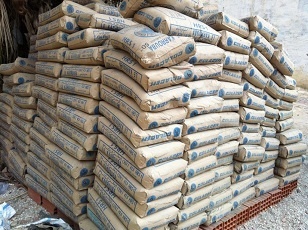Cement is one of the most popular building material. It is used as a binder in the construction industry. It has both adhesion and cohesion properties. It can bind particles into a compact durable solid mass.
Cement has a wide application in the construction industry such as:
- When cement is mixed with sand and water to form a paste, it is termed as mortar. The mortar is used to join bricks or stones and in finishing works such as plastering and pointing.
- When cement is mixed with gravel (or crushed stones), sand and water, the composite product is called concrete. The concrete is the second most used material on this planet. It is used for constructing footings, beams, columns, slabs, stairs, etc.
There are many types of cement which are used as per their requirements and properties

Physical Properties of Cement
The important physical properties of cement are as follows:
Fineness of Cement
The fineness of cement is the measure of the particle size of cement. The finer the cement, greater is the rate of a chemical reaction. This results in a greater rate of strength development.
Very fine cement is also undesirable. It generates greater heat which results in cracks in mortar or concrete. It can also lead to a premature setting.
How to determine the fineness of cement?
The fineness of cement can be determined from particle size distribution or one of the air permeability methods such as Blain’s air permeability method.
Soundness of Cement
The phenomenon of cement to undergo undesirable expansion is termed as unsoundness. When the cement does not undergo a large change in volume, it will be called sound cement.
The unsound cement will disintegrate due to volumetric changes caused by the presence of free lime and magnesia in cement. Unsound cement contains some free lime even after the final grinding. This free lime hydrates very slowly. The free lime covered by a thin film of cement. This prevents direct contact between lime and water.
After the paste has set, moisture penetrates the free lime, and hydration starts. The slaked lime occupies a large volume. Hence expansion takes place. Thus the mortar and concrete made from unsound cement may develop cracks after some time.
How to determine the Soundness of Cement?
Unsoundness is determined by the Le-Chatelier method and Autoclave test.
The unsoundness may be reduced by
(i) Limiting the MgO contents to less than 0.5%.
(ii) Fine grinding
(iii) Aerating the cement for several days
(iv) Through mixing.
Consistency of Cement
The physical state of cement paste is called consistency. The purpose of the consistency test is to estimate the quantity of mixing water to form a paste of normal consistency.
It is measured by the Vicat apparatus Test. If the water content in the cement paste is such that the Vicat’s plunger penetrates up to 5 to 7 mm from the bottom of the mould, the cement paste is called to be of normal consistency.
Setting time of Cement
The setting time of cement is divided into two parts:
- initial setting and
- final setting time.
The time at which the cement paste loses its plasticity after the addition of water is understood as the initial setting time. The time corresponding to the paste becoming a hard mass is known as the final setting time.
The initial setting time is essential for mixing, transporting, and placing of the concrete. At the time of the initial setting, the temperature rises rapidly and at the final set, the temperature reaches a peak value.
How to determine the setting time of cement?
The setting time of cement is determined by Vicat’s Apparatus.
Compressive strength of Cement
The compressive strength test is the final check on the quality of cement and it is the most important test as compared to other cement properties. The grading of cement 33/43/53 is based on compressive strength. The number is the strength of cube 50 cm2 face area in N/mm2
The heat of hydration of Cement
The chemical reaction between cement and water is termed as hydration of cement. The reaction is exothermic i.e. heat is generated during the reaction.
The quantity of heat, in calories per gram of hydrated cement, generated during the process of hydration is known as the heat of hydration.
How to determine the heat of hydration of cement?
The test is carried out over a few days by vacuum flask methods, or over a longer period in an adiabatic calorimeter.
Specific Gravity of Cement
The specific gravity of cement is generally used in mixture proportioning calculations. Portland cement has a specific gravity of 3.15. It may vary depending upon the raw materials used in the manufacturing of cement.
For example, portland-pozzolana cement has a specific gravity of about 2.90.
Why are the physical properties of cement important?
When these physical properties of cement lie in a certain range, one can be sure that cement will perform satisfactorily in most cases. Also, we can compare the qualities of different cement using these properties.
Hence, as a civil engineer, it is must to be familiar with all the physical properties of cement.
Reference:


Worth reading????